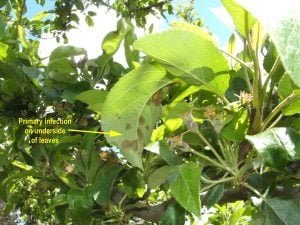These two diseases affect flowers, fruit and foliage causing serious yields and fruit quality losses. They are most likely to occur in the wet seasons and this year blackspot is likely to have a major presence in most grower regions.

Getting under the canopy so that foliage is backlit, can help you to find apple and pear scab leaf infections (Photo: Kevin Dodds – NSW DPI)
Establishment
Infections primarily occur from fallen leaves that were infected the previous season. Young leaves and fruit are the most susceptible and are infected when temperature and leaf wetness conditions are conducive to spore germination. If the disease becomes well established, then fungicide applications may not have a great effect. Therefore, careful management will be required to reduce severity of these diseases for the next season.
Identification
For identification on leaves, lesion development occurs on both sides. Young lesions have spots that are velvety brown to olive green and are noticeable until petal fall. As the lesions get older, they become larger turning dark green to brown.
For identification on fruit, lesions can be seen on flower stalks or young fruit and are small black velvety spots. They are noticeable after petal fall. When the spots grow, they become brown and scabby. The fruit infections will occur in summer and maybe visible before harvest as pinpoint summer spots. However, they may not become evident until storage.
Management
To control scab and prevent primary infections, postharvest sanitization is the key to reducing infection of susceptible plant tissues during the infection periods.
Across the eastern states this season, spray management has been very challenging for many growing areas, with many heavy rain events causing gaps in spray application and efficacy. This may lead to chemical resistance and will require a major focus to managing blackspot through removal of leaf material from orchard floors as soon as practicable for the next season.
More detailed information on scouting notes, thresholds, primary and secondary cycles of these diseases, lifecycle and damage, can be found in the IPDM manual on page 158 ‘Apple and Pear Scab, Venturia inaequalis (apple scab), Venturia pirina (pear scab)’, fans on the Australian apple and pear IPDM webpage: extensionaus.com.au/ozapplepearipdm
Acknowledgements
The PIPS3 program’s Strengthening cultural and biological management of pests and diseases (AP19002) Project has been funded by Hort Innovation, using the apple and pear research levy, contributions from the Australian government and co-investment from Agriculture Victoria. Hort Innovation is the grower owned, not for profit research and Development Corporation for Australian horticulture.
